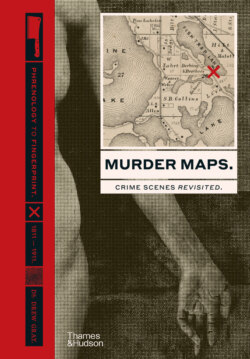Читать книгу Murder Maps - Drew Gray - Страница 11
Оглавление10
Criminals might colour their hair or shave off their beards, even cover up tattoos, but they could not alter their physical dimensions. Then, using the new technology of photography, he recorded all the data, which were then indexed and cross-referenced to enable suspects to be tracked down and prosecuted successfully. Bertillon also invented the ‘mug shot’, the quintessential tool of police forces everywhere, although he gave it the more enigmatic title of portrait parlé, or ‘speaking portrait’. According to an early biographer, ‘He was one of the creators of criminal investigation as an applied science, and he was thus one of the architects of the modern concepts of justice.’
Bertillon’s work intersected with that of others, including the Italian criminologist Cesare Lombroso (1835–1909). In 1876, Lombroso
Le. a japanese exhibit at the 1904 world’s fair in st louis, missouri, displaying criminal identification charts based on alphonse bertillon’s system.
—————Right. brain sections drawn by anthropologist léonce
manouvrier, c. 1900.—————Opposite.alphonse bertillon’s tableau synoptic des traits physionomiques (synoptic table of physiognomic features). it was designed to help police clerks apply his classification system of the human face, known
as
bertillonage
.
published his major work – Criminal Man – in which he set out the concept of the ‘born criminal’ and the case for the study of criminal anthropology. Like Bertillon, Lombroso was fascinated by the physicality of the criminals he studied. He recorded the physical features of prisoners and the bodies of executed felons, and allied particular features with specific sorts of criminal activity. He noted that ‘habitual murderers have a cold, glassy stare and eyes that are sometimes bloodshot and filmy’. Their noses were ‘always large’ and their ‘beards are scanty’. By contrast, rapists had ‘sparkling eyes, delicate features, and swollen lips and eyelids’. He viewed crime as a ‘natural’ activity (i.e. inevitable for some people) rather than an individual choice. Crime would always exist, he argued, and so evolving better methods of detecting it was paramount.
For contemporaries who were familiar with Charles Darwin’s (1809–82) theory of evolution, Lombroso’s thesis of criminal atavism (that some individuals had not developed as quickly or as far as others) sounded rational. Moreover, Lombroso’s scientific approach to criminology chimed with the dominant philosophy of the period, which was scientific positivism.
Cesare Lombroso publishes Criminal Man, a work detailing his theory of criminal typolo.
Francis Galton layers photographs of criminals to establish the ‘average’
criminal face. The first police callboinstalled in New York City.
x is
The London Metropolitan Police introduces the Criminal InvestigaDepartment (CID) with 200 de
tion tectives. American detective Thomas F. Byrnes solves the ManhaSavings Bank robbery.
ttan Alphons
e Bertillon develops the portrait parlé (speaking portrait) identification system. Dr Henr
y Faulds predicts the usefulness of fingerprint analysis to criminolo.
Hermann Reinhard conduct
s a systematic study of insect species inside corpses.
18761877187718781878188018801881
INTRODUCTION.
